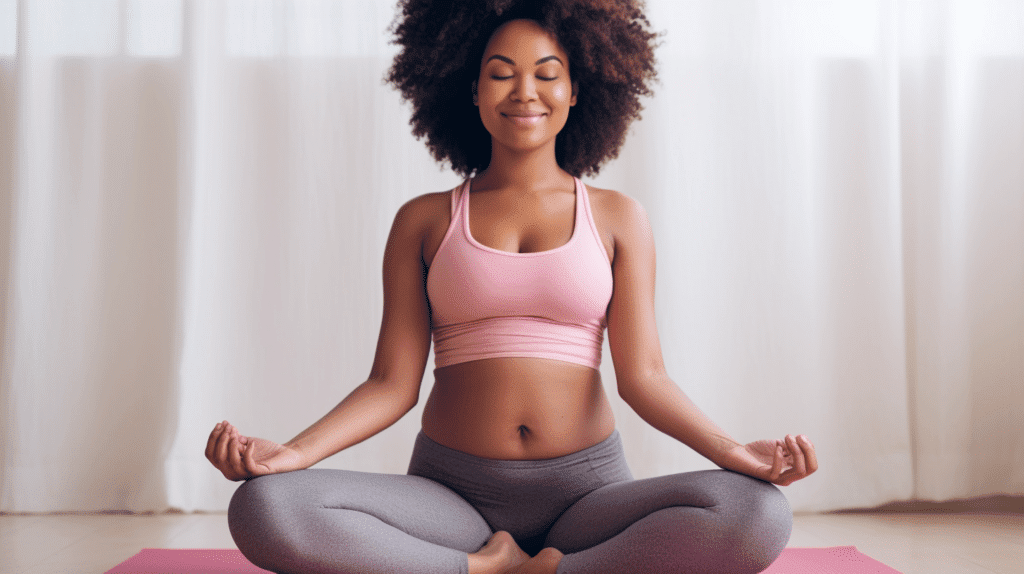Pregnancy is a beautiful and transformative time in a woman’s life, but it can also bring physical discomfort, emotional stress, and new challenges. During this time, it’s essential to take care of yourself and your growing baby in every way possible, and one of the best ways to do that is through regular yoga practice.
Yoga has been practiced for thousands of years to promote physical, mental, and emotional health, and it can be especially beneficial during pregnancy. Incorporating safe and effective yoga poses into your daily routine can help ease discomfort, reduce stress and anxiety, and prepare your body for a healthy and successful pregnancy, birth, and postpartum recovery.
If you’re in Houston, you’re in luck! Motherhood Center is Houston’s only full-time prenatal yoga, fitness, and Pilates studio studio. They offer a wide range of classes and packages designed to support women through every stage of pregnancy and beyond.
This comprehensive guide will explore the best yoga poses for a healthy pregnancy and provide tips and guidance for practicing safely and effectively. From standing to seated poses, forward bends to twists, and hip openers to restorative poses, we’ll cover everything you need to know to support your body and prepare for the transformative journey of motherhood.
So grab your yoga mat, take a deep breath, and let’s get started.
Benefits of Yoga during Pregnancy
 Yoga can offer numerous benefits for women during pregnancy. These benefits can include physical, mental, and emotional improvements.
Yoga can offer numerous benefits for women during pregnancy. These benefits can include physical, mental, and emotional improvements.
One of yoga’s most significant physical benefits during pregnancy is improved flexibility and strength. As the body changes to accommodate the growing baby, many women experience discomfort and pain in their joints and muscles. Yoga poses can help stretch and strengthen these areas, reducing pain and improving mobility. Additionally, practicing yoga during pregnancy can improve circulation, reduce swelling, and alleviate common discomforts such as back pain, sciatica, and leg cramps.
Yoga can also positively impact mental and emotional well-being during pregnancy. Pregnancy can be stressful and emotional; practicing yoga can help reduce stress and anxiety. By focusing on breath and movement, yoga can help to calm the mind and promote relaxation. Additionally, prenatal yoga classes’ social support and community aspect can benefit women who may feel isolated or unsupported during pregnancy.
Another significant benefit of practicing yoga during pregnancy is preparation for labor and delivery. Many yoga poses can help to stretch and strengthen the muscles used during childbirth, such as the pelvic floor and abdominals. Additionally, the breathwork and relaxation techniques practiced during yoga can be useful during labor, helping women to remain calm and focused during this intense and transformative experience.
The benefits of practicing yoga during pregnancy can be wide-ranging and significant. By incorporating safe and effective yoga poses into their daily routine, women can promote physical and mental well-being for themselves and their growing baby.
Precautions to Take Before Starting Yoga During Pregnancy
While yoga can offer numerous benefits for pregnant women, taking certain precautions before starting a yoga practice during pregnancy is important. Here are some precautions to keep in mind:
- Consult with your healthcare provider: Before starting a yoga practice during pregnancy, it’s important to consult with your healthcare provider to ensure that it is safe for you and your baby. Your healthcare provider can also recommend specific poses to avoid or modify.
- Choose a qualified prenatal yoga instructor: Not all yoga instructors are trained to teach prenatal yoga. It’s important to choose a qualified prenatal yoga instructor who has experience working with pregnant women and who can provide modifications for various stages of pregnancy. Since many of Motherhood Center’s instructors have been with us for several years and are well-versed in prenatal yoga techniques, they provide optimum instruction to either the novice or the most experienced.
- Avoid certain poses: While many yoga poses can be beneficial during pregnancy, some poses should be avoided or modified to accommodate the changing body. Poses that involve twisting, deep backbends, inversions, or lying on the stomach should generally be avoided. Additionally, poses involving jumping or sudden movements should be avoided as they can stress the joints and pelvic floor.
- Listen to your body: As with any physical activity during pregnancy, it’s important to listen to your body and take breaks when needed. Overexertion can lead to fatigue, dizziness, and other discomforts. It’s important to rest when needed and modify poses to accommodate your changing body.
- Stay hydrated: Pregnant women should aim to stay hydrated throughout the day, especially during physical activity such as yoga. Be sure to bring a water bottle to class and to take sips of water as needed. Motherhood Center has an onsite water fountain to keep your bottles full!
By taking these precautions, women can safely and effectively incorporate yoga into their prenatal routine, reaping its numerous benefits.
Best Yoga Poses for a Healthy Pregnancy
 Here are some of the best yoga poses for a healthy pregnancy:
Here are some of the best yoga poses for a healthy pregnancy:
Standing Poses
Standing poses are essential to any yoga practice and beneficial during pregnancy. Here are some standing poses that are safe and effective for pregnant women:
Warrior II (Virabhadrasana II):
This pose helps to strengthen the legs and open the hips. Step back your left foot from a standing position and turn it to a 90-degree angle. Your right foot should be pointing forward. Raise your arms parallel to the floor, with your shoulders relaxed. Hold the pose for several deep breaths, then repeat on the other side.
Triangle (Trikonasana):
This pose can help to stretch the hamstrings, hips, and spine. From a standing position, step your feet wide apart. Turn your right foot out to a 90-degree angle and your left foot slightly inward. Extend your arms out to the sides, then reach forward with your right hand and place it on your shin or ankle. Extend your left arm up toward the ceiling. Hold the pose for several deep breaths, then repeat on the other side.
Tree (Vrikshasana):
This pose helps to improve balance and strengthen the legs. Begin by standing with your feet hip-distance apart. Shift your weight onto your left foot and place your right foot on your inner left thigh. Press your foot into your thigh and your thigh into your foot, then bring your hands together at your heart. Hold the pose for several deep breaths, then repeat on the other side.
Chair (Utkatasana):
This pose helps to strengthen the legs and glutes. Begin by standing with your feet hip-distance apart. Bend your knees and lower your hips as if you were sitting back into a chair. Raise your arms overhead and keep your shoulders relaxed. Hold the pose for several deep breaths, then release.
As with any yoga practice during pregnancy, it’s important to listen to your body and modify poses as necessary. If any standing poses feel uncomfortable or cause pain, taking a break or modifying the pose to make it more comfortable is important. A qualified prenatal yoga instructor can guide modifications and adjustments to make the practice safe and effective for pregnant women.
Seated Poses
 Seated poses can be an excellent way for pregnant women to practice yoga, as they allow for a greater sense of grounding and stability. Here are some seated poses that are safe and effective for pregnant women:
Seated poses can be an excellent way for pregnant women to practice yoga, as they allow for a greater sense of grounding and stability. Here are some seated poses that are safe and effective for pregnant women:
Bound Angle Pose (Baddha Konasana):
This pose helps to open the hips and groin. Sit on the floor with your legs extended in front of you, then bend your knees and bring the soles of your feet together. Use your hands to press your knees toward the floor gently, then sit tall and take several deep breaths.
Seated Forward Fold (Paschimottanasana):
This pose can help to stretch the hamstrings and lower back. Sit on the floor with your legs extended in front of you, then bend forward from the hips and reach for your feet or ankles. Keep your spine long and your shoulders relaxed, then take several deep breaths.
Easy Pose (Sukhasana):
This pose is a comfortable seated position that can help to improve posture and promote relaxation. Sit on the floor with your legs crossed and your hands resting on your knees. Keep your spine long and your shoulders relaxed, then take several deep breaths.
Cow Face Pose (Gomukhasana):
This pose helps to open the hips and shoulders. Sit on the floor with your legs crossed, then stack your right knee on top of your left knee. Reach your right arm toward the ceiling, bend your elbow, and reach your hand behind your back. Reach your left arm behind your back and try to clasp your hands together. Hold the pose for several deep breaths, then repeat on the other side.
Paying attention to your body and adjusting poses as needed during a yoga practice while pregnant is crucial. If any seated poses feel uncomfortable or result in pain, it’s essential to take a break or modify the pose to suit your needs.
Forward Bends
Forward bends are a common type of yoga pose that can be beneficial for pregnant women. These poses can help to stretch the muscles in the back of the body, including the hamstrings, calves, and lower back. Here are some safe and effective forward bend poses for pregnant women:
Standing Forward Bend (Uttanasana):
This pose can help to stretch the hamstrings and lower back. Stand with your feet hip-width apart and slowly fold forward, bending from the hips. Allow your head and neck to relax, and reach for your shins or the floor. Hold the pose for several deep breaths, then slowly roll up to standing.
Seated Forward Bend (Paschimottanasana):
This pose can help to stretch the hamstrings and lower back. Sit on the floor with your legs extended in front of you, then bend forward from the hips and reach for your feet or ankles. Keep your spine long and your shoulders relaxed, then take several deep breaths.
Wide-Legged Forward Bend (Prasarita Padottanasana):
This pose can help to stretch the inner thighs and hamstrings. Stand with your feet wider than hip-width apart, then fold forward and reach for the floor. Allow your head and neck to relax, and hold the pose for several deep breaths.
It’s important to modify forward bends as needed during pregnancy. Avoid rounding the spine or compressing the belly, as this can be uncomfortable or even harmful. Instead, focus on keeping the spine long and the shoulders relaxed. Use blocks or props as needed to make the poses more comfortable and accessible.
Twists
Twist poses can be helpful for pregnant women as they can help to improve digestion, relieve tension in the back and hips, and create space for the baby. However, it’s essential to modify twists during pregnancy to avoid any discomfort or strain on the body. Here are some safe and effective twist poses for pregnant women:
Seated Twist (Ardha Matsyendrasana):
Sit on the floor with your legs extended in front of you. Bend your right knee and place your right foot on the floor, then cross your left foot over your right knee. Twist your torso to the right, placing your left hand on your right knee and your right hand behind your back. Take several deep breaths, then repeat on the other side.
Supine Twist (Supta Matsyendrasana):
Lie on your back with your knees bent and feet on the floor. Cross your right leg over your left thigh, then twist your legs to the left. Extend your arms out to the sides, and turn your head in the opposite direction of your legs. Take several deep breaths, then repeat on the other side.
Chair Twist (Parivrtta Utkatasana):
Stand with your feet hip-width apart and your arms extended overhead. Bend your knees and lower your hips as if you’re sitting in a chair. Twist your torso to the right, placing your left elbow on your right knee and your hands in prayer. Take several deep breaths, then repeat on the other side.
Hip Openers
Hip opener poses can be beneficial during pregnancy as they can help to prepare the body for childbirth and relieve tension in the hips and lower back. However, it’s essential to practice hip opener poses with caution and make modifications as necessary to avoid any discomfort or strain on the body. Here are some safe and effective hip opener poses for pregnant women:
Pigeon Pose (Eka Pada Rajakapotasana):
Begin on all fours with your hands and knees on the floor. Bring your right knee forward and place it behind your right hand. Extend your left leg behind you, keeping your hips square. Slowly lower your upper body to the floor, resting on your forearms. Take several deep breaths, then repeat on the other side.
Bound Angle Pose (Baddha Konasana):
Sit on the floor with the soles of your feet touching and your knees out to the sides. Hold your feet with your hands, and gently press your knees toward the floor. Sit up tall and take several deep breaths.
Wide-Legged Forward Fold (Prasarita Padottanasana):
Stand with your feet wider than hip-width apart, toes pointing forward. Fold forward, placing your hands on the floor or on blocks. Keep your knees bent if needed, and focus on lengthening your spine and opening your hips.
Restorative Poses
Restorative yoga poses can be incredibly beneficial during pregnancy, as they help to relax the body and reduce stress and anxiety. These poses typically involve gentle stretching and relaxation, which can help promote restful sleep and improve overall well-being. Here are some restorative yoga poses that are safe and effective for pregnant women:
Supported Reclined Bound Angle Pose (Supta Baddha Konasana):
Lie on your back with a bolster or pillow placed under your upper back and head. Bring the soles of your feet together, allowing your knees to fall out to the sides. Place a pillow or bolster under each knee for support, and allow your arms to rest by your sides. Close your eyes and take several deep breaths, allowing your body to relax and release tension.
Supported Child’s Pose (Balasana):
Begin on all fours, with your hands and knees on the floor. Place a bolster or pillow on the floor in front of you, and rest your torso on it, extending your arms forward. Allow your forehead to rest on the bolster, and take several deep breaths, feeling your body relax and release tension.
Legs-Up-The-Wall Pose (Viparita Karani):
Lie on your back with your legs extended up against a wall. You can use a pillow or bolster under your hips for support. Allow your arms to rest by your sides, and close your eyes. Take several deep breaths, feeling the gentle stretch in your legs and the relaxation in your body.
Restorative poses are great for helping to reduce stress and anxiety during pregnancy, but it’s important to practice them with caution. Avoid any poses that cause discomfort or strain on the body, and use props or modifications as needed to make the poses more comfortable and accessible.
Conclusion
In conclusion, practicing yoga during pregnancy can be a wonderful way to support your physical, mental, and emotional well-being. By incorporating these safe and effective poses into your daily routine, you can help to ease discomfort, reduce stress and anxiety, and prepare your body for a healthy pregnancy, birth, and postpartum recovery.
If you’re in Houston and looking to start or continue your prenatal yoga journey, we recommend checking out Motherhood Center. With their experienced and qualified instructors, diverse class offerings, and supportive community, you’ll have all the necessary resources to feel empowered and prepared for the journey ahead.
So why wait? Sign up for a class today and experience the benefits of prenatal yoga. Whether you’re a beginner or an experienced yogi, Motherhood Center has something to offer every mom-to-be. Your body and your baby will thank you.
FAQs about Prenatal Yoga & Fitness
Is it safe to practice yoga during pregnancy?
Yes, yoga can be a safe and effective way to maintain a healthy pregnancy. However, it is important to take certain precautions and consult with a healthcare provider before starting any new exercise program.
What are the benefits of practicing yoga during pregnancy?
Yoga can help to reduce stress and anxiety, improve sleep quality, increase flexibility and strength, relieve back pain and other discomforts, and prepare the body for labor and delivery.
What should I avoid when practicing yoga during pregnancy?
It is important to avoid hot yoga, poses that require a lot of balance or strength, and poses that involve lying on your back for an extended period of time after the first trimester. It is also important to listen to your body and not push yourself beyond your limits.
Can yoga help to prepare the body for labor and delivery?
Certain yoga poses can help prepare the body for labor and delivery by stretching and strengthening the muscles used during childbirth.
How can I find a qualified and experienced prenatal yoga teacher?
You can ask for recommendations from your healthcare provider, friends, or family members. You can also search for prenatal yoga classes online or in your local community.



